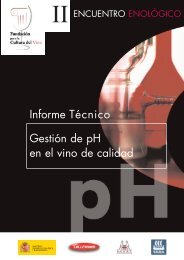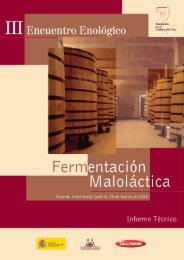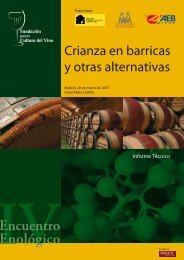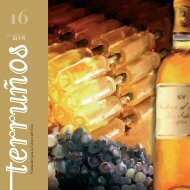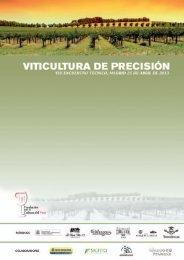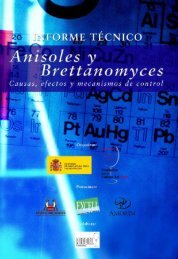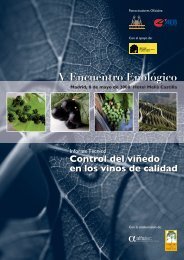Influ<strong>en</strong>ce of the Timing of Nitrog<strong>en</strong> Additions during Synthetic Grape Must Ferm<strong>en</strong>tations on Ferm<strong>en</strong>tation Kinetics and Nitrog<strong>en</strong> ConsumptionFigure 3. Re<strong>la</strong>tive g<strong>en</strong>e expression of GAP1 andMEP2 at differ<strong>en</strong>t points in the first 24 h after th<strong>en</strong>itrog<strong>en</strong> addition. Time zero repres<strong>en</strong>ts the pointjust before this addition. The data were calcu<strong>la</strong>tedas in Figure 2.Figure 3 shows the g<strong>en</strong>e expression of GAP1 andMEP2 in the first 24 h after the nitrog<strong>en</strong> addition. Theywere both repressed in all the ferm<strong>en</strong>tations. However,the <strong>la</strong>ter the addition took p<strong>la</strong>ce in the ferm<strong>en</strong>tationprocess, the longer it took for the g<strong>en</strong>es to be repressed.Wh<strong>en</strong> nitrog<strong>en</strong> was added at the <strong>en</strong>d of theferm<strong>en</strong>tation (d<strong>en</strong>sity 1000), the effect was negligiblebecause of the low expression at this point.Analytical Profile. We analyzed the residual sugars,ethanol, glycerol, and acids in the wines obtainedfrom the differ<strong>en</strong>t ferm<strong>en</strong>tations and such f<strong>la</strong>vor compoundsas higher alcohols, vo<strong>la</strong>tile fatty acids, and esters,which arose from yeast metabolism (Table 3). The<strong>la</strong>ter the nitrog<strong>en</strong> addition was, the lower the conc<strong>en</strong>trationof glycerol, acetic acid, and acetaldehyde was.The higher alcohol cont<strong>en</strong>t was lower wh<strong>en</strong> excessnitrog<strong>en</strong> was avai<strong>la</strong>ble at the beginning of the ferm<strong>en</strong>tation(control ferm<strong>en</strong>tation and N1060). Thesediffer<strong>en</strong>t conc<strong>en</strong>trations were accounted for by theincrease in isoamyl alcohol and 2-ph<strong>en</strong>ylethanol.The conc<strong>en</strong>tration of these compounds increasedconsiderably in the ferm<strong>en</strong>tations with nitrog<strong>en</strong> additionsin the <strong>la</strong>ter phases (or no addition), and wereapproximately 2 and 5 times higher than in the controlferm<strong>en</strong>tation. The increase in isoamyl alcohol didnot lead to a corresponding clear increase in its ester(isoamyl acetate) in these ferm<strong>en</strong>tations, and theph<strong>en</strong>yl-2-ethanol acetate ester only increased slightly.In fact, the differ<strong>en</strong>ces in the conc<strong>en</strong>tration of thetotal acetate esters betwe<strong>en</strong> the ferm<strong>en</strong>tations weredue to the conc<strong>en</strong>tration of ethyl acetate, which wasmore than 95% of the total acetate esters.Table 3. Secondary Metabolites Produced by Yeastsduring the Differ<strong>en</strong>t Ferm<strong>en</strong>tations aIts conc<strong>en</strong>tration was higher in the control ferm<strong>en</strong>tationand the N1060 and 1040 ferm<strong>en</strong>tations, whichcorre<strong>la</strong>ted with a higher acetate conc<strong>en</strong>tration. Thediffer<strong>en</strong>ces in the conc<strong>en</strong>tration of fatty acids andtheir esters were smaller in the final products of theferm<strong>en</strong>tations.DISCUSSIONcontrolferm. N1060 N1040 N1020 N1000no NadditionAlcohols and Acids (gL 1)ethanol 98.7 97.2 98.0 98.0 98.7 101.1glycerol 6.56 6.57 6.32 6.11 5.78 6.12acetate 1.17 1.22 0.98 0.80 0.89 0.81acetaldehyde 0.33 0.28 0.26 0.25 0.24 0.22citrate 0.41 0.41 0.38 0.41 0.39 0.41succinate 0.13 0.21 0.27 0.26 0.23 0.23<strong>la</strong>ctate 0.04 0.05 0.04 0.03 0.02 0.02Higher Alcohols (mg L 1)n-propanol 37 33 28 20 13 12isobutanol 11 13 16 16 16 16isoamylic alcohol 50 48 81 97 94 94ph<strong>en</strong>yl-2-ethanol 11 21 42 46 53 43109 115 167 179 176 165Fatty Acids (mg L 1)isobutyric acid 0.39 0.40 0.43 0.39 0.50 0.41butyric acid 0.63 0.73 0.67 0.72 0.59 0.60isovaleric acid 0.63 0.37 0.30 0.44 0.80 0.60valeric acid 0.12 0.09 0.09 0.10 0.18 0.15hexanoic acid 2.06 1.58 1.40 1.53 1.90 1.85octanoic acid 2.30 1.95 1.84 2.34 2.43 2.49decanoic acid 0.39 0.37 0.21 0.19 0.14 0.46dodecanoic acid 0.16 0.14 0.09 0.16 0.32 0.286.70 5.63 5.02 5.87 6.86 6.83Acetate Esters (mg L 1 )ethyl acetate 35 35 32 25 19 28isobutyl acetate 0.023 0.024 0.012 0.016 0.011 0.011isoamyl acetate 0.49 0.46 0.39 0.69 0.39 0.29hexyl acetate 0.006 0.005 − − − −ph<strong>en</strong>yl-2-ethanol acetate 0.21 0.37 0.41 0.47 0.41 0.2935.73 35.86 32.81 26.18 19.81 28.59Fatty Acid Esters (mg L 1)ethyl butyrate 0.224 0.220 0.163 0.232 0.164 0.124ethyl isobutyrate 0.006 0.005 0.006 0.005 0.004 0.007ethyl hexanoate 0.089 0.071 0.23 0.31 0.23 0.085ethyl octanoate 0.022 0.022 0.060 0.081 0.059 0.020ethyl decanoate 0.002 0.004 0.019 0.024 0.019 0.0040.343 0.322 0.478 0.652 0.446 0.240aValues are the average of two determinations and thecoeffici<strong>en</strong>t of variation in all the compounds analyzedwas less than 10% with the exception of decanoic acid(18%), dodecanoic acid (38%), ethyl octanoate (16%),and ethyl decanoate (29%).The addition of nitrog<strong>en</strong> to grape musts, especiallyin the form of ammoniacal nitrog<strong>en</strong>, is a commonwinemaking practice that prev<strong>en</strong>ts nitrog<strong>en</strong>-re<strong>la</strong>tedferm<strong>en</strong>tation problems. Several studies, in whichgrape musts were supplem<strong>en</strong>ted with diammoniumphosphate, have proved that nitrog<strong>en</strong> supplem<strong>en</strong>tscan optimize ferm<strong>en</strong>tation performance (2-4). In thepres<strong>en</strong>t study, we supplem<strong>en</strong>ted a nitrog<strong>en</strong>-defici<strong>en</strong>tsynthetic must with a mixture of ammonium and aminoacids at differ<strong>en</strong>t stages of the alcoholic ferm<strong>en</strong>tation.Th<strong>en</strong> we studied the effect of these additions on46
Seminario Técnico<strong>Compuestos</strong> <strong>azufrados</strong> volátiles <strong>en</strong> <strong>vinos</strong>the ferm<strong>en</strong>tation kinetics, the consumption of organicand inorganic nitrog<strong>en</strong> throughout the ferm<strong>en</strong>tation,and the influ<strong>en</strong>ce of this consumption on the aromacompound profile of the wines.We observed a reduction in the ferm<strong>en</strong>tation l<strong>en</strong>gthregardless of the time of addition and, consequ<strong>en</strong>tly, areduction in the total ferm<strong>en</strong>tation time. However, theferm<strong>en</strong>tation l<strong>en</strong>gth decreased ev<strong>en</strong> further wh<strong>en</strong> nitrog<strong>en</strong>was added during the expon<strong>en</strong>tial phase andyeast cells probably used this nitrog<strong>en</strong> for biomassproduction. These results <strong>la</strong>rgely agree with thosepreviously reported (2-4). However, the yeast strainQA23 used in this study seems to have low nitrog<strong>en</strong>requirem<strong>en</strong>ts. It used only 147 mg N L -1 in the controlferm<strong>en</strong>tation and finished it with only 60 mg N L -1 .Ag<strong>en</strong>bach (25) established that ferm<strong>en</strong>tations requirea minimal amount of 140 mg N L -1 to avoid gettingstuck. In fact, nitrog<strong>en</strong> demands and prefer<strong>en</strong>ces arestrain dep<strong>en</strong>d<strong>en</strong>t (26-28) and, therefore, it should betak<strong>en</strong> into account that we only used one strain.As in previous experim<strong>en</strong>tal studies (2, 6), we observedthat nitrog<strong>en</strong> additions during the period of cellgrowth resulted in an increase in cell biomass. Duringthe cell growth phase of the ferm<strong>en</strong>tation, most carbon-and nitrog<strong>en</strong>-containing compounds are divertedto biomass production. Wh<strong>en</strong> growth stops,however, only small amounts of these nutri<strong>en</strong>ts arerequired, primarily for cell maint<strong>en</strong>ance (3).The metabolism of nitrog<strong>en</strong> dep<strong>en</strong>ds heavily on itsuptake through the differ<strong>en</strong>t nitrog<strong>en</strong> transporters. Inthis study, we monitored the activity of the g<strong>en</strong>es <strong>en</strong>codingtwo important permeases in the transport ofamino acids (GAP1) and ammonium (MEP2) throughoutferm<strong>en</strong>tation. In a previous study (5), we observedthat both permeases were repressed in a nitrog<strong>en</strong>-richmedium by the mechanism called nitrog<strong>en</strong>catabolite repression (NCR). The pres<strong>en</strong>t study confirmsthis repression because in the control ferm<strong>en</strong>tationtheir expressions were almost negligible andin the limiting nitrog<strong>en</strong> condition their expressionsdropped sharply at the beginning, wh<strong>en</strong> nitrog<strong>en</strong> wasstill avai<strong>la</strong>ble, and increased continuously wh<strong>en</strong> it wasnot. The NCR of both transporters was fast and effective,as se<strong>en</strong> with the nitrog<strong>en</strong> additions, although thecell response to the excess of nitrog<strong>en</strong> in the mediumwas quicker wh<strong>en</strong> the nitrog<strong>en</strong> addition was in thefirst half of ferm<strong>en</strong>tation. During the <strong>la</strong>st stages of ferm<strong>en</strong>tation,ethanol cont<strong>en</strong>t is high and it is well establishedthat the first target of ethanol toxicity is thep<strong>la</strong>sma membrane (29, 30), which can be impaired fora long period of anaerobic growth. Therefore, the s<strong>en</strong>singsystem of the cell, mainly located in the p<strong>la</strong>smamembrane, may be affected by both effects (31).The mom<strong>en</strong>t of the ferm<strong>en</strong>tation process at whichthe NCR was established (by the nitrog<strong>en</strong> addition)determined the pattern of amino acid consumption.As previously reported (9), arginine, a<strong>la</strong>nine, aspartate,glutamate, and glycine were the amino acids that weremost affected by the NCR because they were hardlyconsumed wh<strong>en</strong> there was an excess of nitrog<strong>en</strong>. Infact, they were not tak<strong>en</strong> up until the medium was depletedof good nitrog<strong>en</strong> sources. These amino acidsmust be transported mainly by the g<strong>en</strong>eral amino acidpermease (Gap1p) or by other specific permeases alsosubjected to NCR. A simi<strong>la</strong>r uptake pattern for theseamino acids was previously reported in both syntheticand natural grape juices (1, 26). On the other hand, inbrewing conditions (32) arginine and glutamine wererapidly consumed whereas ammonium uptake wasde<strong>la</strong>yed. Branched-chain and aromatic amino acidsbehaved in a completely differ<strong>en</strong>t way.Except for tryptophan, they were mostly consumedin the first stages of the control ferm<strong>en</strong>tation: that is,wh<strong>en</strong> the cells were subjected to NCR from the beginningof the ferm<strong>en</strong>tation process. A common featureof the g<strong>en</strong>es that <strong>en</strong>code the permeases of thebranched-chain amino acids (BAP1 and BAP2) andaromatic amino acids (TAT1 and TAT2) is that they areinduced in a nitrog<strong>en</strong>-rich medium (33, 34).Regardless of the time of addition, glutamine andtryptophan were the main amino acids consumed afterthe nitrog<strong>en</strong> additions, and therefore, they may bevery important for the yeast cell metabolism throughoutthe process.Ammonium accounted for 40% of the total YAN ofthe ferm<strong>en</strong>tation media. However, its consumptiondep<strong>en</strong>ded on the timing of the addition. Ammoniumis the preferred nitrog<strong>en</strong> source for biomass productionbut was hardly consumed wh<strong>en</strong> it was added inthe final stages of the ferm<strong>en</strong>tation. These differ<strong>en</strong>cesin ammonium uptake are difficult to exp<strong>la</strong>in in termsof permease regu<strong>la</strong>tion. In the pres<strong>en</strong>t study and inour previous one (9), we detected that, the more nitrog<strong>en</strong>there was in the ferm<strong>en</strong>tation media, the morerepressed the three MEP g<strong>en</strong>es were. Marini et al. (35)have proposed two possible hypotheses to exp<strong>la</strong>inthis <strong>para</strong>dox: either the yeast possesses additiona<strong>la</strong>mmonium transport systems unre<strong>la</strong>ted to the Mepproteins, or highly conc<strong>en</strong>trated ammonium is tak<strong>en</strong>up into the cells by simple diffusion.The timing of the nitrog<strong>en</strong> additions directly determinedthe likely aroma characteristics of the wines.Glycerol increased in the ferm<strong>en</strong>tations with higherbiomass production and higher ammonium consumption.The re<strong>la</strong>tionship betwe<strong>en</strong> biomass formationand glycerol synthesis has already be<strong>en</strong> reported(36- 38). Likewise, a higher glycerol yield was also observedon a synthetic glucose-rich medium wh<strong>en</strong> ammoniumwas used as the sole nitrog<strong>en</strong> source insteadof a mixture of ammonium and amino acids (39). Michnicket al. (40) also re<strong>la</strong>ted the production of glycerolto the accumu<strong>la</strong>tion of acetate and acetaldehyde.Textos asociados47



